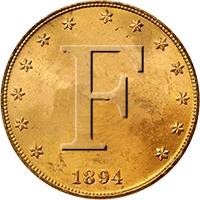I'm not an electronic engineer. But I'll take a stab at it.............
Detector coils are comprised of transmit windings and receive windings. The transmit portion sends an electronic signal into the earth. When that signal crosses paths with a metallic object, that metallic object creates it's own electronic signal (opposite polarity) which is "picked up" by the receive portion of the coil. The signal coming back to the receive windings is delayed, in comparison to the signal that was transmitted. This delay is caused by resistance (opposition to current flow) and inductance (opposition to the change of current flow) and is called a phase shift. Every metal object that gets involved with the transmit and receive coils provides its own phase shift. And through demodulation, the X-TERRA identifies these metal objects based on their phase shift(s). Larger phase shifts are created by objects that are primarily inductors and good conductors of electricity such as gold, silver and copper. Smaller phase shifts are created by objects whose metallic properties make it more resistive and less conductive. Examples would be a square nail or bottle cap. As to coins of the same metallic content, larger coins have less resistance (more conductivity) than a smaller coin of the same composition. Therefore, a quarter will have a different phase shift than a dime or half dollar. Anyway, as the demodulation takes place, the software of the X-TERRA will evaluate the phase shift of each target, assign a value based on the phase shift information, and route each target's value to the notch segment that has been "assigned" those values. When a target is routed to a notch segment, you will hear an audio tone associated with that segment, and see the TID representing the target. With the X-TERRA 70 and 705, there are 28 notch segment possibilities for that target to be matched up with. The 30, 305, 50 and 505 have fewer notch segments than the 70 or 705. So the software that processes the phase shift information and routes the target value will differ on each model. What number is displayed on the TID will depend on whether the detector has two digit notch segments (X-70 and X-705) , three digit notch segments (X-50 and X505) or 4 digit notch segments (X-30 and X-305). The tone you hear will depend on how you programmed your detector.
Now comes the magic.........as you stated, silver dimes and clad dimes do not have the same metallic make up. BUT remember, software can route any target to any notch that has been established in programming, based on each target's phase shift. So they assign the phase shift value of clad dimes to the same notch segment as they do the phase shift value of silver dimes. Clad quarters are sent to the same notch segment as silver quarters. Buffalo nickels are sent to the same notch segment as modern Jeffersons. Etc. etc. etc. It isn't about what a target looks like, it's monetary value or even it's metallic make up. (ever dig an aluminum screw cap, thinking it is going to be a quarter?) It's all about the electronic signal sent to the target, the delay in eddy currents sent back, and the phase shift produced by each target. Once the detector recognizes the phase shift information, software routes the information and the microprocessor provides the audio and visual target information to the user.
Again, I may or may not know what I am talking about.

And I'm sure I way over-simplified it.

But as I analyze the X-TERRA and how it functions, it makes perfect sense to me!

JMHO HH Randy

 And I'm sure I way over-simplified it.
And I'm sure I way over-simplified it.  But as I analyze the X-TERRA and how it functions, it makes perfect sense to me!
But as I analyze the X-TERRA and how it functions, it makes perfect sense to me!  JMHO HH Randy
JMHO HH Randy